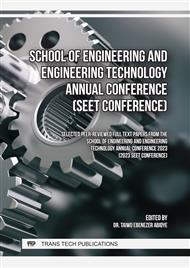[1]
K.V. Wong, and A. Hernandez. A review of additive manufacturing. International scholarly research notices, 2012.
Google Scholar
[2]
W.E. Frazier, Metal additive manufacturing: A review. Journal of Materials Engineering and performance, 23, 1917-1928. (2014).
Google Scholar
[3]
D.H. Ding, Z. X. Pan, C. Dominic, and H. J. Li,. Process planning strategy for wire and arc additive manufacturing. In Robotic Welding, Intelligence and Automation: RWIA'2014 (pp.437-450). (2015). Springer International Publishing.
DOI: 10.1007/978-3-319-18997-0_37
Google Scholar
[4]
B.D. Bankong, T.E. Abioye, T.O. Olugbade, H. Zuhailawati, O.O. Gbadeyan and T.I. Ogedengbe. A Review of post-processing methods for high-quality wire arc additive manufacturing. (2022).
DOI: 10.1080/02670836.2022.2110223
Google Scholar
[5]
A.D. Baghi, S. Nafisi, R. Hashemi, H. Ebendorff-Heidepriem, and R. Ghomashchi. Effective post processing of SLM fabricated Ti-6Al-4 V alloy: Machining vs thermal treatment. Journal of Manufacturing Processes, 68, 1031-1046. (2001).
DOI: 10.1016/j.jmapro.2021.06.035
Google Scholar
[6]
C.S. Ramesh, and R. Keshavamurthy, Influence of forging on mechanical properties of Ni–P coated Si3N4 reinforced Al6061 composites. Materials Science and Engineering: A, 551, 59-66. (2012).
DOI: 10.1016/j.msea.2012.04.081
Google Scholar
[7]
Z.A. Mierzejewska, R. Hudák, and J. Sidun. Mechanical properties and microstructure of DMLS Ti6Al4V alloy dedicated to biomedical applications. Materials, 12(1), 176. (2019).
DOI: 10.3390/ma12010176
Google Scholar
[8]
P. Bidare, A. Jiménez, H. Hassanin, and K. Essa, Porosity, cracks, and mechanical properties of additively manufactured tooling alloys: a review. Advances in Manufacturing, 1-30. (2022).
DOI: 10.1007/s40436-021-00365-y
Google Scholar
[9]
N. Razavi, A. Avanzini, G. Cornacchia, L. Giorleo, and F. Berto. Effect of heat treatment on fatigue behavior of as-built notched Co-Cr-Mo parts produced by Selective Laser Melting. International Journal of Fatigue, 142, 105926. (2021).
DOI: 10.1016/j.ijfatigue.2020.105926
Google Scholar
[10]
V. R. Duarte, T. A. Rodrigues, N. Schell, R. M. Miranda, J. P. Oliveira, and T. G. Santos. Hot forging wire and arc additive manufacturing (HF-WAAM). Additive Manufacturing, 35, 101193. (2020).
DOI: 10.1016/j.addma.2020.101193
Google Scholar
[11]
H. Shen, J. Lin, Z. Zhou, and B. Liu. Effect of induction heat treatment on residual stress distribution of components fabricated by wire arc additive manufacturing. Journal of Manufacturing Processes, 75, 331-345. (2022).
DOI: 10.1016/j.jmapro.2022.01.018
Google Scholar
[12]
B. Völker, V. Maier-Kiener, K. Werbach, T. Müller, S. Pilz, M. Calin, and A. Hohenwarter, Influence of annealing on microstructure and mechanical properties of ultrafine-grained Ti45Nb. Materials & Design, 179, 107864. (2019).
DOI: 10.1016/j.matdes.2019.107864
Google Scholar
[13]
D. Xie, F. Lv, Y. Yang, L. Shen, Z. Tian, C. Shuai, and J. Zhao. A review on distortion and residual stress in additive manufacturing. Chinese Journal of Mechanical Engineering: Additive Manufacturing Frontiers, 100039. (2002).
DOI: 10.1016/j.cjmeam.2022.100039
Google Scholar
[14]
T. E. Abioye, Y. W. Chuah, H. Zuhailawati, and A. B. Abdullah. "Enhancing the single-track deposition quality of AISI 308L wire arc additive manufacturing via process optimization and cold forging treatment." Proceedings of the Institution of Mechanical Engineers, Part E: Journal of Process Mechanical Engineering (2023): 09544089231215203.
DOI: 10.1177/09544089231215203
Google Scholar
[15]
I. S. Omotehinse, T. E. Abioye, A. S. Anasyida, and B. O. Omiyale. Review of Parametric Strategies for Enhancing the Mechanical and Wear Properties of Friction Stir Processed Aluminium Alloys Composites. Transactions of the Indian Institute of Metals, 76(8), 2009-203. (2023)
DOI: 10.1007/s12666-023-02919-z
Google Scholar
[16]
Z. Li, J. Wang, and H. Huang. Influences of grain/particle interfacial energies on second-phase particle pinning grain coarsening of polycrystalline. Journal of Alloys and Compounds, 818, 152848. (2020).
DOI: 10.1016/j.jallcom.2019.152848
Google Scholar


